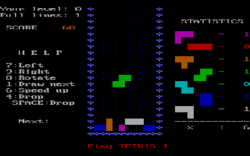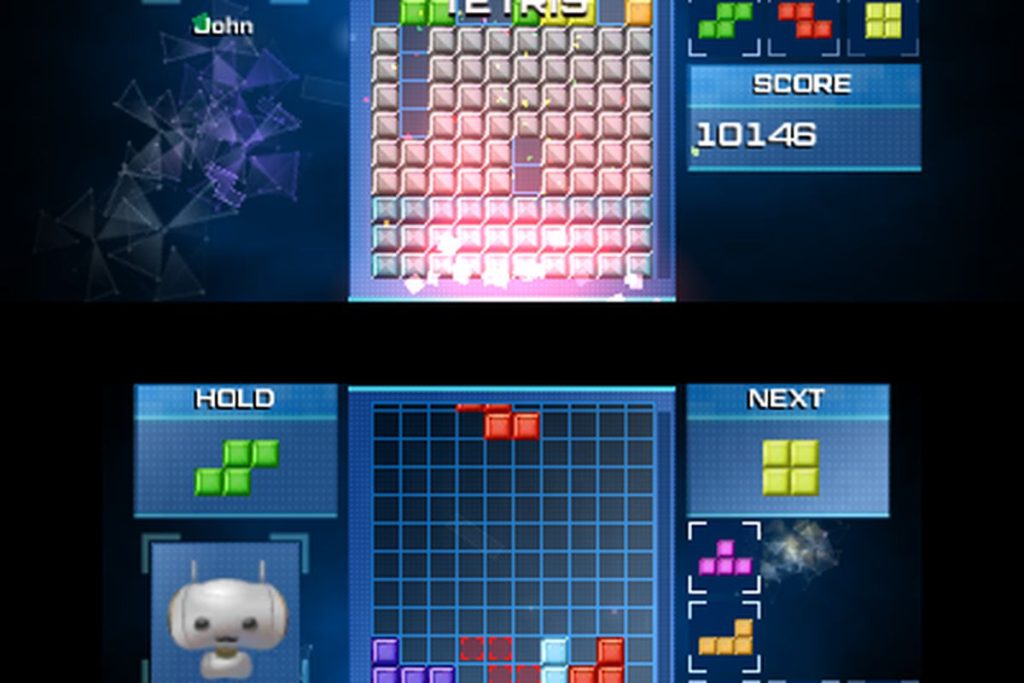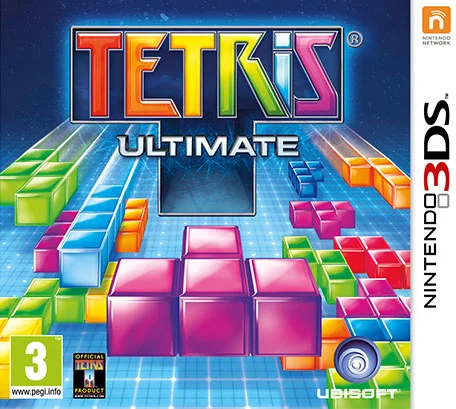Tetris Japan
Tetris Japan (Russian: Тетрис[a]) is a puzzle video game created in 1985 by Alexey Pajitnov, a Soviet software engineer.[1] It has been published by several companies for multiple platforms, most prominently during a dispute over the appropriation of the rights in the late 1980s. After a significant period of publication by Nintendo, the rights reverted to Pajitnov in 1996, who co-founded the Tetris Company with Henk Rogers to manage licensing.
In Tetris, players complete lines by moving differently shaped pieces (tetrominoes), which descend onto the playing field. The completed lines disappear and grant the player points, and the player can proceed to fill the vacated spaces. The game ends when the uncleared lines reach the top of the playing field. The longer the player can delay this outcome, the higher their score will be. In multiplayer games, players must last longer than their opponents; in certain versions, players can inflict penalties on opponents by completing a significant number of lines. Some versions add variations on the rules, such as three-dimensional displays or a system for reserving pieces.
Built on simple rules, Tetris established itself as one of the greatest video games ever made. By December 2011, it had sold 202 million copies – approximately 70 million physical units and 132 million paid mobile game downloads – making it one of the best-selling video game franchises. The Game Boy version is one of the best-selling games of all time, with more than 35 million copies sold. Tetris is available on over 65 platforms, setting a Guinness world record for the most ported video game. Tetris is rooted within popular culture and its popularity extends beyond the sphere of video games; imagery from the game has influenced architecture, music, and cosplay. The game also has been the subject of various research studies that have analyzed its theoretical complexity and have shown its effect on the human brain following a session, in particular the Tetris effect.
Gameplay – Tetris Japan
Tetris is primarily composed of a field of play in which pieces of different geometric forms, called “tetrominoes“, descend from the top of the field.[2] During this descent, the player can move the pieces laterally and rotate them until they touch the bottom of the field or land on a piece that had been placed before it.[3] The player can neither slow down the falling pieces nor stop them, but can accelerate them, in most versions.[4]: 4 [5] The objective of the game is to use the pieces to create as many complete horizontal lines of blocks as possible. When a line is completed, it disappears, and the blocks placed above fall one rank.[3] Completing lines grants points, and accumulating a certain number of points or cleared lines moves the player up a level, which increases the number of points granted per completed line.[4]: 16
In most versions, the speed of the falling pieces increases with each level, leaving the player with less time to think about the placement.[3] The player can clear multiple lines at once, which can earn bonus points in some versions.[2] It is possible to complete up to four lines simultaneously with the use of the I-shaped tetromino; this move is called a “Tetris”, and is the basis of the game’s title.[4]: 16
If the player cannot make the blocks disappear quickly enough, the field will start to fill; when the pieces reach the top of the field and prevent the arrival of additional pieces, the game ends.[3] At the end of each game, the player receives a score based on the number of lines that have been completed.[4]: 16 The game never ends with the player’s victory. The player can complete only as many lines as possible, before an inevitable loss.[2]
Since 1996, the Tetris Company has internally defined specifications and guidelines to which publishers must adhere to be granted a license to Tetris. The contents of these guidelines establish elements such as the correspondence of buttons and actions, the size of the field of play, and the system of rotation.[6][7]
Game pieces – Tetris Japan

The pieces on which the game of Tetris is based around are called “tetrominoes”. Pajitnov’s original version for the Electronika 60 computer used green brackets to represent the blocks that make up tetrominoes.[8] Versions of Tetris on the original Game Boy/Game Boy Color and on most dedicated handheld games use black-and-white or grayscale graphics, but most popular versions use a separate color for each distinct shape. Prior to the Tetris Company’s standardization in the early 2000s, those colors varied widely from implementation to implementation.
Scoring – Tetris Japan
The scoring formula for the majority of Tetris products is built on the idea that more difficult line clears should be awarded more points. For example, a single line clear in Tetris Zone is worth 100 points, clearing four lines at once (known as a Tetris) is worth 800, while each subsequent back-to-back Tetris is worth 1,200.[9] In conjunction, players can be awarded combos that exist in certain games which reward multiple line clears in quick succession. The exact conditions for triggering combos, and the amount of importance assigned to them, vary from game to game.[citation needed]
Nearly all Tetris games allow the player to press a button to increase the speed of the current piece’s descent or cause the piece to drop and lock into place immediately, known as a “soft drop” and a “hard drop”, respectively. While performing a soft drop, the player can also stop the piece’s increased speed by releasing the button before the piece settles into place. Some games only allow either soft drop or hard drop; others have separate buttons for both. Many games award a number of points based on the height that the piece fell before locking, so using the hard drop generally awards more points.
Infinite game question – Tetris Japan
In 1992, John Brzustowski wrote a thesis reflecting on the question of whether or not one could theoretically play Tetris forever.[10] He reached the conclusion that the game is statistically doomed to end. If a player receives a sufficiently large sequence of alternating S and Z Tetrominoes, the naïve gravity used by the standard game eventually forces the player to leave holes on the board. The holes will necessarily stack to the top and, ultimately, end the game. If the pieces are distributed randomly, this sequence will eventually occur. Thus, if a game with, for example, an ideal, uniform, uncorrelated random number generator is played long enough, any player will almost surely top out.[11][12]
Modern versions of Tetris released after 2001 use a bag-style randomizer that guarantees players will never receive more than four S and Z pieces in a row by shuffling tetrominoes of all types for each 7 pieces.[13]5:20 This is one of the “Indispensable Rules” enforced by the Tetris Guideline that all officially licensed Tetris games must follow.[7]
Easy spin dispute – Tetris Japan
“Easy spin”, or “infinite spin”,[14] is a feature in some Tetris games where a tetromino stops falling for a moment after left or right movement or rotation, effectively allowing the player to suspend the piece while deciding where to place it. The mechanic was introduced in 1999’s The Next Tetris,[citation needed] and drew criticism in reviews of 2001’s Tetris Worlds.[14]
This feature has been implemented into the Tetris Company‘s official guideline.[7] This type of play differs from traditional Tetris because it takes away the pressure of higher level speed. Some reviewers[15] went so far as to say that this mechanism broke the game. The goal in Tetris Worlds, however, is to complete a certain number of lines as fast as possible, so the ability to hold off a piece’s placement will not make achieving that goal any faster. Later, GameSpot received “easy spin” more openly, saying that “the infinite spin issue honestly really affects only a few of the single-player gameplay modes in Tetris DS, because any competitive mode requires you to lay down pieces as quickly as humanly possible.”[16]
Henk Rogers stated in an interview that infinite spin was an intentional part of the game design, allowing novice players to expend some of their available scoring time to decide on the best placement of a piece. Rogers observed that “gratuitous spinning” does not occur in competitive play, as expert players do not require much time to think about where a piece should be placed. A limitation has been placed on infinite lock delay in later games of the franchise, where after a certain amount of rotations and movements, the piece will instantly lock itself. This is defaulted to 15 such actions.[7]
History – Tetris Japan

The first version of Tetris, completed in 1985, run on an emulator of the Electronika 60

A screenshot of the 1986 IBM PC version developed by Dmitry Pavlovsky and Vadim Gerasimov

The version designed by Spectrum Holobyte contained Soviet-related images (Amiga version screenshot, 1988)
Conception – Tetris Japan
In 1979, Alexey Pajitnov joined the Computer Center of the Soviet Academy of Sciences as a speech recognition researcher. While he was tasked with testing the capabilities of new hardware, his ambition was to use computers to make people happy.[17]: 85 Pajitnov developed several puzzle games on the institute’s computer, an Electronika 60, a scarce resource at the time due in part to CoCom.[18]: 298 [13]1:50 For Pajitnov, “games allow people to get to know each other better and act as revealers of things you might not normally notice, such as their way of thinking”.[17]: 85
In 1984, while trying to recreate a favorite puzzle game from his childhood featuring pentominoes,[19] Pajitnov imagined a game consisting of a descent of random pieces that the player would turn to fill rows.[17]: 85 Pajitnov felt that the game would be needlessly complicated with twelve different shape variations, so he scaled the concept down to tetrominoes, of which there are seven variants.[20] Pajitnov titled the game Tetris, a word created from a combination of “tetra” (meaning “four”) and his favorite sport, “tennis“.[21][13]1:20
Because the Electronika 60 had no graphical interface, Pajitnov modelled the field and pieces using spaces and brackets[18]: 299 (45 lines of 80 ASCII characters).[13]1:50 Realizing that completed lines filled the screen quickly, Pajitnov decided to delete them, creating a key part of Tetris gameplay.[20] This early version of Tetris had no scoring system and no levels, but its addictive quality distinguished it from the other puzzle games Pajitnov had created.[22] Pajitnov wrote the game using Pascal for the RT-11 operating system on the Electronika 60.[13]1:50
Pajitnov had completed the first playable version of Tetris c. 1985.[23][24] Pajitnov presented Tetris to his colleagues, who quickly became addicted to it.[17]: 87 It permeated the offices within the Academy of Sciences, and within a few weeks it reached every Moscow institute with a computer.[17]: 87 [25]: 9 min A friend of Pajitnov, Vladimir Pokhilko, who requested the game for the Moscow Medical Institute, saw people stop working to play Tetris. Pokhilko eventually banned the game from the Medical Institute to restore productivity.[17]: 87
Pajitnov sought to adapt Tetris to the IBM Personal Computer, which had a higher quality display than the Electronika 60. Pajitnov recruited Vadim Gerasimov, a 16-year-old high school student who was known for his computer skills.[17]: 87 [18]: 300 Pajitnov had met Gerasimov before through a mutual acquaintance, and they had worked together on previous games.[8] Gerasimov adapted Tetris to the IBM PC over the course of a few weeks, incorporating color and a scoreboard.[18]: 300 The PC port was written with Turbo Pascal.

Tetremix E
Tetremix C
Tetremix B
Tetremix D
Tetremix A











